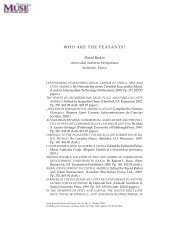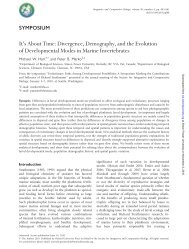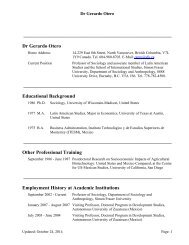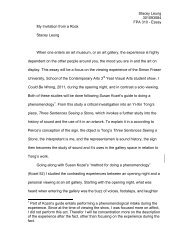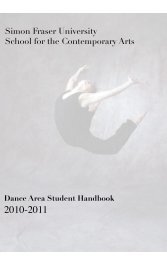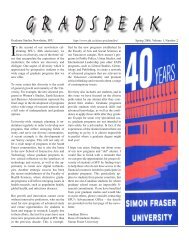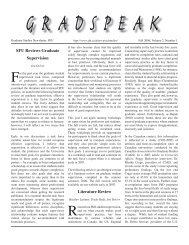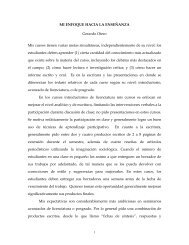Lexicon-Based Methods for Sentiment Analysis - Simon Fraser ...
Lexicon-Based Methods for Sentiment Analysis - Simon Fraser ...
Lexicon-Based Methods for Sentiment Analysis - Simon Fraser ...
Create successful ePaper yourself
Turn your PDF publications into a flip-book with our unique Google optimized e-Paper software.
Computational Linguistics Volume 37, Number 2<br />
amount of disagreement; if it were simply the case that some −1 words were judged<br />
by all rankers as neutral (or positive), the best explanation <strong>for</strong> that fact would be errors<br />
in individual SO values. If Turkers, however, generally agree about SO 5/−5 words,<br />
but generally disagree about SO 1/−1 words, this “unreliability” actually reflects the<br />
SO scale. This is indeed the pattern we see in the data: Average pairwise agreement is<br />
60.1% <strong>for</strong> 1/−1 words, but 98.2% <strong>for</strong> 5/−5 (see Andreevskaia and Bergler [2006] <strong>for</strong><br />
similar results in a study of inter-annotator agreement in adjective dictionaries). 25<br />
Interestingly, although we expected relatively equal numbers of positive and negative<br />
judgments at SO = 0, that was not the result. Instead, words with SO = 0 were<br />
sometimes interpreted as positive, but almost never interpreted as negative. This is<br />
mostly likely attributable to the default status of positive, and the marked character of<br />
negative expression (Boucher and Osgood 1969; Horn 1989; Jing-Schmidt 2007); neutral<br />
description might be taken as being vaguely positive, but it would not be mistaken <strong>for</strong><br />
negative expression. 26<br />
For the word-pair task, we categorize the distribution data by the difference in SO<br />
between the two words, putting negative and positive words in separate tables. For<br />
instance, a −4 difference with negative adjectives means the result of comparing a −1<br />
word to a −5 word, and a +2 difference corresponds to comparing a −5 with a negative<br />
−3, a −4 witha−2, or a −3 witha−1. (We always compare words with the same sign,<br />
i.e., negative to negative.) In early testing, we found that Turkers almost completely<br />
ignored the same category, and so we took steps (changing the instructions and the<br />
order of presentation) to try to counteract this effect. Still, the same designation was<br />
underused. There are a number of possible explanations <strong>for</strong> this, all of which probably<br />
have some merit. One is that our scale is far too coarse-grained, that we are collapsing<br />
distinguishable words into a single classification. The trade-off here is with ease of<br />
ranking; if we provided, <strong>for</strong> instance, 20 SO values instead of 10, it would be more<br />
difficult to provide confident rankings, and would probably yield little in the way of<br />
tangible benefits. 27 Another potential confounding factor is that words within the same<br />
SO category often vary considerably on some other dimension, and it is not natural to<br />
think of them as being equivalent. For instance, we judged savory, lush, andjolly to be<br />
equally positive, but they are applied to very different kinds of things, and so are not<br />
easily compared. And, of course, even assuming our 10-point scale, there are words in<br />
our dictionary that do not belong together in the same category; our focus here is on<br />
the big picture, but we can use this data to identify words which are problematic and<br />
improve the dictionary in the next iteration.<br />
The results in Figures 2 and 3 <strong>for</strong> the adjective word pair task are otherwise very<br />
encouraging. Unlike the single word task, we see a clear linear pattern that covers<br />
the entire SO spectrum (though, again, there is noise). At SO value difference = 0,<br />
same reaches a maximum, and positive and negative judgments are almost evenly<br />
distributed. The average pairwise agreement on this task was somewhat lower, 60.0%<br />
25 Note also that another drawback with pairwise agreement is that agreement does not change linearly<br />
with respect to the number of dissenters. For example, in the six-rater task, a single disagreement drops<br />
agreement from 100% to 66.7%; a second disagreement drops the score to 40% if different than the first<br />
agreement, or 46.7% if the same.<br />
26 This is the opposite result from the impressions reported by Cabral and Hortaçsu (2010), where, in an<br />
evaluation of comments <strong>for</strong> eBay sellers, neutral comments were perceived as close to negative.<br />
27 Other evidence that suggests making our scale more fine-grained is unlikely to help: When two words<br />
were difficult to distinguish, we often saw three different answers across the six Turkers. For example, <strong>for</strong><br />
−3SOwordsfat and ignorant, three Turkers judged them the same, two judged ignorant as stronger, and<br />
one judged fat as stronger.<br />
290


